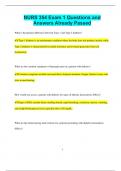NURS 354 Exam 1 Questions and
Answers Already Passed
What is the primary difference between Type 1 and Type 2 diabetes?
✔✔Type 1 diabetes is an autoimmune condition where the body does not produce insulin, while
Type 2 diabetes is characterized by insulin resistance and eventual pancreatic beta-cell
dysfunction.
What are the common symptoms of hyperglycemia in a patient with diabetes?
✔✔Common symptoms include increased thirst, frequent urination, fatigue, blurred vision, and
slow wound healing.
How would you assess a patient with diabetes for signs of diabetic ketoacidosis (DKA)?
✔✔Signs of DKA include fruity-smelling breath, rapid breathing, confusion, nausea, vomiting,
and a high blood glucose level, typically above 250 mg/dL.
What are the initial nursing interventions for a patient presenting with diabetic ketoacidosis
(DKA)?
1
,✔✔The initial interventions include administering intravenous fluids to rehydrate, administering
insulin to reduce blood glucose levels, and monitoring electrolytes, especially potassium, to
prevent imbalances.
What are the most common long-term complications of poorly managed diabetes?
✔✔Long-term complications include cardiovascular disease, neuropathy, nephropathy,
retinopathy, and poor wound healing.
What is the importance of blood glucose monitoring in diabetes management?
✔✔Blood glucose monitoring helps patients assess their insulin needs, track their blood sugar
trends, and avoid complications like hypoglycemia or hyperglycemia by making necessary
adjustments.
What is the role of insulin in the management of diabetes, and how does it differ in Type 1 and
Type 2 diabetes?
✔✔Insulin is essential for regulating blood glucose levels. In Type 1 diabetes, insulin therapy is
required because the body no longer produces insulin, while in Type 2 diabetes, insulin may be
needed in later stages when oral medications no longer control blood glucose levels.
What are the primary nursing interventions for a patient with diabetic neuropathy?
2
,✔✔Primary interventions include educating the patient on proper foot care, monitoring for
wounds or infections, managing blood sugar levels, and providing pain management strategies.
How can a nurse assist a diabetic patient in preventing foot complications?
✔✔The nurse should educate the patient on daily foot inspections, proper footwear, keeping feet
clean and dry, and avoiding walking barefoot to prevent injury and infection.
What are the signs and symptoms of hypoglycemia, and how should they be managed?
✔✔Signs of hypoglycemia include shakiness, sweating, confusion, irritability, and rapid heart
rate. Management includes administering a fast-acting carbohydrate like glucose tablets or juice
and re-checking blood glucose levels after 15 minutes.
How does exercise affect blood glucose levels in diabetic patients?
✔✔Exercise helps to lower blood glucose levels by increasing insulin sensitivity. However,
patients should monitor their blood glucose before, during, and after exercise to prevent
hypoglycemia.
What is the role of diet in managing diabetes, and what are some key dietary recommendations?
3
, ✔✔A balanced diet that focuses on controlling carbohydrate intake, maintaining a healthy
weight, and managing blood sugar levels is essential. Key recommendations include eating fiber-
rich foods, choosing whole grains, and limiting processed sugars.
What are the complications associated with diabetes and hypertension, and how can they be
prevented?
✔✔Complications of diabetes and hypertension include heart disease, stroke, and kidney
damage. Preventive measures include blood pressure control, blood sugar management, a healthy
diet, and regular exercise.
What are the differences in the management of Type 1 and Type 2 diabetes during periods of
illness?
✔✔During illness, both types of diabetes require close monitoring of blood glucose, but Type 1
diabetics are at higher risk for DKA. Type 2 diabetics may need adjustments to oral medications
or insulin. It is important for both types to stay hydrated and check blood sugar frequently.
What role does the HbA1c test play in the management of diabetes?
✔✔The HbA1c test reflects the average blood glucose level over the past 2-3 months. It is used
to assess long-term glucose control and to adjust treatment plans for diabetic patients.
4




